
July last year was the beginning of a saga that drew us into the natural world in a dramatic and fulfilling way. The distinctive call of a pair of Masked Lapwing Plovers on our flat roof drew our attention and we noticed they were guarding three eggs they had laid there. Once the chicks hatched they resembled tiny balls of black cotton wool and they began to fall onto our balconies below. We consulted with WIRES (Wildlife Information, Rescue and Education Service) and were told that plovers nest in flat open spaces like fields or flat roofs, rather than in trees. They were apparently looking for lower ground and it was suggested we move the babies and that the parents would follow. We placed them on an embankment across the road. This was an unfortunate choice as within days all three chicks had been run over by cars.
Tragically, the parents continued to return to the nature strip outside our house making distress calls as they searched for their young. Some weeks later when we spotted three new eggs on our roof, we took them to a safer location this time to ensure their survival. When the first of the chicks dropped into our garden, we placed all three in a recycling box and walked slowly down to Vaucluse House (a beautiful heritage property 300 meters down the road from our home which is situated on 25 acres of land). As the chicks would cheep, the parents were prompted to follow.
After observing the parents and three chicks dancing happily through the grass, we felt delighted that our job was done. We had escorted the young family to what seemed an ideal and safe environment away from the road. A trip down to Vaucluse House the following day revealed that there were now only two chicks left. The greatest threat to the chicks’ survival in the first two weeks of life are larger birds, though dogs and cats also present a risk.
Three days later there was no trace of the chicks or parents at Vaucluse House and we returned home resigned to accept the mystery of their disappearance, only to find the parents and one chick now roaming in the road outside our house. They had walked back to their nesting site, our home! We repeated the procedure of coaxing the parents back to Vaucluse House, leading them down with their cheeping baby in the box.
Concerned that they would walk home again, we put up a small enclosure in the grounds of Vaucluse House to house the baby as night fell. If she could not walk out, presumably the parents would not come home again. This failed as the parents refused to enter the enclosure and we found the baby a little later slumped against the fence of the enclosure. It was weak, cold and very stressed having been away from its parents for a couple of hours and we doubted whether it would survive. We hastily removed the fencing and the faithful parents returned, one immediately sitting on her young, keeping her warm and reviving her.
The next day we were relieved to find her alive and prancing happily in the sunshine through the long grass; however by night all three had walked home again. No amount of coaxing would persuade the parents to follow us all the way to Vaucluse House. They would follow a short distance and then fly back up to our roof. Left alone at Vaucluse House, our four day old chick would certainly die, and being left on the nature strip with her parents carried the same risks. So that night, with the view that the only place the parents were willing to be was on our roof, we lugged bricks onto the roof and built an enclosure there so the baby could not fall off, while her parents could come and go at will. Once again, the parent sat on the baby to protect her through the night.
Our next call to WIRES however confirmed that the parents would not bring her food on the roof. She needed to access food herself from the ground, as plovers feed themselves from birth. After four days of frenzied activity to do everything possible to keep the baby safe, we realized we had no choice but to adopt her. We quickly mowed our lawn and my husband built an enclosure occupying most of our garden (about 11 x 9 m) to screen our plover family off from our dogs. WIRES suggested that we place the baby there and put out water and mealworms to attract her parents. This time the parents did follow the baby into the enclosure and our plover nursery was born. The blinds came down to cover our glass doors, so our Maltese-Pekinese could not scare the parents. We put fresh bowls of chicken starter crumble out daily as a complete food for our new family member. This was supplemented with mealworms three times a day, alfalfa sprouts and finely chopped boiled egg and egg shells. We were told she would fly any time between six and nine weeks old and so we postponed our travel arrangements to stay in Sydney till our ‘Lucky’ (what else could we call her?) could fly away safely.
Everything was now in place for our plover family’s little piece of paradise. The most fascinating aspect of our newly-arrived nuclear family is what wonderful parents they are. They are so protective of their young. One parent did not leave her side, remaining on the grass with her while the second parent patrolled on the roof above and would swoop down when it perceived that the baby was under threat or when I came out with food.
When the bird was two weeks old we observed a Kookaburra eyeing her from the tree above and the parent swooping up repeatedly to scare it away. When Lucky was three weeks old we had torrential rain and were intrigued to see how the mother sat for 12 hours on her baby to keep her warm and dry as the rain poured down over her. When she was five weeks old she was often seen outside alone as both parents had retreated to the roof, patrolling there and only coming down at mealtimes. Perhaps they were teaching her independence or demonstrating to her how to leave. From five weeks old she also spent much time preening her feathers, spreading her majestic wings and doing a little hop, skip and jump across the grass while lifting off. These then developed into little flights - circuits of the garden. When she was seven weeks she flew over our pool fence and we found her walking up and down the tarpaulin we had used to cover our pool for her protection. We guided her to fly back into the enclosure and she spent two more blissful days with us in her first home.
When Lucky was seven weeks and two days old we found the enclosure empty. She and her parents had left and the true meaning of the phrase ‘empty nest’ began to sink in. We found them 100 meters down the road on the nature strip where they spent most of the day. We were unsure whether Lucky was strong enough to fly from danger, as orphan plovers are usually released from captivity only at approximately nine weeks old. However, our Lucky had the gigantic advantage of having her devoted parents at her side and they would apparently remain together for six months or even up to two years. We attempted to move them off the road and down to Vaucluse House. At that point Lucky reassured us by taking off and soaring into the heavens with her parents not far behind. What a joyous and exhilarating moment for Lucky, her parents and of course for us. We knew then that we had beaten the odds. While one in nine plovers usually survive in urban areas, Lucky was one of six to survive!
Her second day exposed to a world much vaster than the one she was accustomed to in her little haven in our garden saw her at Vaucluse House at the very spot to which we had tried to escort her and her parents seven weeks earlier. Over the next few days they returned intermittently to our nature strip and our roof, the parents dropping back into our garden only once for a final feed. A week after their departure we saw them pecking happily in the grass at Vaucluse Bay. From time to time we also hear their very distinctive and identifiable calls, reminding us that they are not far away and reassuring us that Lucky is safe in her parents’ care. What a gentle and reassuring departure for us, to be able to observe her during this week. Although we will deeply miss our Lucky, there is great joy in knowing that she has had a wonderfully safe, protected and well-nourished couple of months during which she has been introduced into the world. Let’s hope life treats her kindly. And if the parents return to their same nesting spot on our roof in the spring next year we will be knowledgeable enough about these beautiful creatures and equipped to save all three chicks … and who knows, they may bring Lucky with them.
We feel so privileged to have been part of such a special happening, witnessing the immense and tireless devotion of Lucky’s parents, which drove us to any lengths to ensure she survived. How inspirational nature’s ways are; we learnt much about devoted care, about how these parents taught their chick, protected her and then knew how to let go and give her independence. We derived enormous satisfaction from seeing them fulfill their purpose in life; to procreate and see their chick grow to its full potential. We feel grateful to WIRES, our helpful adviser in keeping Lucky alive, with her parents and in the best health.
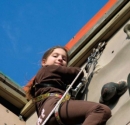 DEAR EDITOR 157 MAGAZINE
DEAR EDITOR 157 MAGAZINE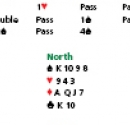 COUNTING ON INFERENCE
COUNTING ON INFERENCE SHULAMIT LAMIE RAVINSKY 1925-2010
SHULAMIT LAMIE RAVINSKY 1925-2010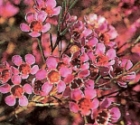 From Australia with Love
From Australia with Love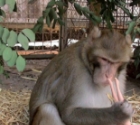 Monkey Tales
Monkey Tales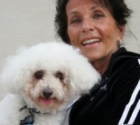 A fresh spirit of Zionism from Manhattan
A fresh spirit of Zionism from Manhattan Beverly Tow
Beverly Tow